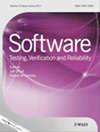一个失败的证明可以产生一个有用的测试
IF 1.2
4区 计算机科学
Q3 COMPUTER SCIENCE, SOFTWARE ENGINEERING
引用次数: 1
摘要
在软件验证中,一个成功的自动化程序证明是最终的胜利。然而,在实践中,通往这种成功的道路是由许多失败的证明尝试铺成的。与失败的测试不同,失败的测试提供了程序中实际错误的具体证据,而失败的证明使程序员处于黑暗中。我们能从中学到一些有用的东西吗?这里报告的工作利用了一些自动证明者在尝试证明时内部收集的关于程序的丰富信息。如果证明失败,本文中提供的Proof2Test工具使用由证明者生成的反例(具体来说,是AutoProof系统中使用的Boogie工具底层的SMT求解器,用于执行配备合约的Eiffel程序的正确性证明)来生成失败的测试,这为程序员提供了立即可利用的信息来纠正程序。讨论介绍了Proof2Test及其思想和工具在一系列代表性示例中的应用。本文章由计算机程序翻译,如有差异,请以英文原文为准。

A failed proof can yield a useful test
Abstract A successful automated program proof is, in software verification, the ultimate triumph. In practice, however, the road to such success is paved with many failed proof attempts. Unlike a failed test, which provides concrete evidence of an actual bug in the program, a failed proof leaves the programmer in the dark. Can we instead learn something useful from it? The work reported here takes advantage of the rich information that some automatic provers internally collect about the program when attempting a proof. If the proof fails, the Proof2Test tool presented in this article uses the counterexample generated by the prover (specifically, the SMT solver underlying the Boogie tool used in the AutoProof system to perform correctness proofs of contract‐equipped Eiffel programs) to produce a failed test, which provides the programmer with immediately exploitable information to correct the program. The discussion presents Proof2Test and the application of the ideas and tool to a collection of representative examples.
求助全文
通过发布文献求助,成功后即可免费获取论文全文。
去求助
来源期刊

Software Testing Verification & Reliability
工程技术-计算机:软件工程
CiteScore
3.70
自引率
0.00%
发文量
34
审稿时长
>12 weeks
期刊介绍:
The journal is the premier outlet for research results on the subjects of testing, verification and reliability. Readers will find useful research on issues pertaining to building better software and evaluating it.
The journal is unique in its emphasis on theoretical foundations and applications to real-world software development. The balance of theory, empirical work, and practical applications provide readers with better techniques for testing, verifying and improving the reliability of software.
The journal targets researchers, practitioners, educators and students that have a vested interest in results generated by high-quality testing, verification and reliability modeling and evaluation of software. Topics of special interest include, but are not limited to:
-New criteria for software testing and verification
-Application of existing software testing and verification techniques to new types of software, including web applications, web services, embedded software, aspect-oriented software, and software architectures
-Model based testing
-Formal verification techniques such as model-checking
-Comparison of testing and verification techniques
-Measurement of and metrics for testing, verification and reliability
-Industrial experience with cutting edge techniques
-Descriptions and evaluations of commercial and open-source software testing tools
-Reliability modeling, measurement and application
-Testing and verification of software security
-Automated test data generation
-Process issues and methods
-Non-functional testing
 求助内容:
求助内容: 应助结果提醒方式:
应助结果提醒方式:


